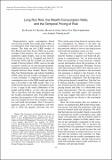Long Run Risk, the Wealth-Consumption Ratio, and the Temporal Pricing of Risk
Author(s)
Koijen, Ralph S. J.; Lustig, Hanno; Nieuwerburgh, Stijn Van; Verdelhan, Adrien Frederic
Downloadaer 100 2.pdf (160Kb)
PUBLISHER_POLICY
Publisher Policy
Article is made available in accordance with the publisher's policy and may be subject to US copyright law. Please refer to the publisher's site for terms of use.
Terms of use
Metadata
Show full item recordAbstract
Representative agent consumption based
asset pricing models have made great strides in
accounting for many important features of asset
returns. The long run risk (LRR) models of
Ravi Bansal and Amir Yaron (2004) are a prime
example of this progress. Yet, several other representative
agent models, such as the external
habit model of John Y. Campbell and John H.
Cochrane (1999) and the variable rare disasters
model of Xavier Gabaix (2008), seem to be able
to match a similar set of asset pricing moments.
Additional moments would be useful to help distinguish
between these models. Hanno Lustig,
Stijn Van Nieuwerburgh, and Adrien Verdelhan
(2009) argue that the wealth-consumption ratio
is such a moment. A comparison of the wealthconsumption
ratio in the LRR model and in the
data is favorable to the LRR model. This is no
small feat because the wealth-consumption ratio
is not a target in the usual calibrations of the
model, and the LRR is—so far—the sole model
able to reproduce both the equity premium and
the wealth-consumption ratio. The LRR model
matches the properties of the wealth-consumption
ratio despite the fact that it implies a negative
real bond risk premium. This is because it
generates quite a bit of consumption cash flow
risk to offset the negative discount rate risk.
Date issued
2010-05Department
Sloan School of ManagementJournal
American Economic Review
Publisher
American Economic Association
Citation
Koijen, Ralph S.J et al. “Long Run Risk, the Wealth-Consumption Ratio, and the Temporal Pricing of Risk.” American Economic Review 100 (2010): 552-556. Web. 21 Dec. 2011. © 2010 American Economic Association
Version: Final published version
ISSN
0002-8282
1944-7981